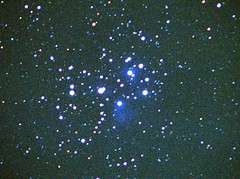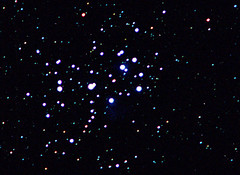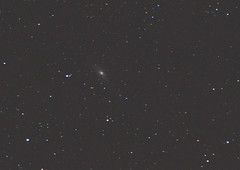

Both images above were from the same slide, just processed a little
differently in Photoshop. The images were taken using my Konica camera and a Soligor zoom
lens with an IDAS light pollution filter. The camera was then piggybacked on
my Ultima C8. The lens was set at 260mm and f/4.5. The exposure was for 20 minutes. The
film was Kodak Elite Chrome 200.
The image on the left was adusted to try to bring out as much of the nebulocity as possible. The
image on the right was adusted to try to make the background dark. I was unable to get both
features on the same image in photoshop.
You can see where my tracking wasn't prefect since the
stars aren't nice perfect circles. I was able to capture stars dimmer than 12th magnitude in the
image. I was also very pleased that I was able to capture some nebulocity.
Piggyback images of M31 (the Andromeda Galaxy) with zoom lens

The image above was taken with the same camera, lens, and film. The zoom lens was
at 100mm and f/4.5. The exposure was for 10 minutes.
This one was actually my first piggyback shot with the zoom lens. After developing the film, I
see that I did not zoom in enough to the image. Unfortunatly I can only see the very bightest of
objects in the viewfinder of the camera, so before I can really zoom in on a object, I would need
to make sure that the camera and telescope are aligned. You can also see some of my tracking
errors in this image as well.
In addition to M31, you can also see M32, even though it looks like a star. You can
also just
barely make out M101 just a little above and to the right of the core of M31.
|